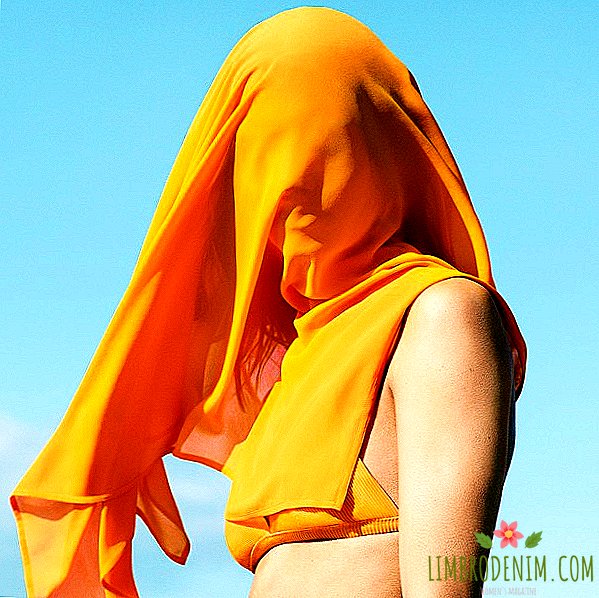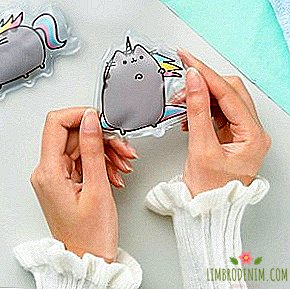Everything you need to know about tanning: The benefits, harm, aging of the skin and protection
With the arrival of summer instead of hopeless clouds we finally get enough of the sun - and we enter into very different relationships with it: someone is regularly hiding from him, and someone is struggling to get a tan. Many of those who do not belong to any of the camps, but feel that everything is not so simple, have long wanted to understand once and for all which of the two extremes has more common sense. So that this summer the sun was only a joy, we offer an educational program: we understand how solar radiation affects the appearance and health of the skin, what the vicissitudes of a tanning salon are and what to look for when choosing solar protection.

Why it is believed that sunbathing is helpful
Many sunbathers take sunbathing not only for their golden skin. The society has firmly established the opinion that it is extremely useful to sunbathe and, moreover, it is necessary - in particular for the production of vitamin D in the skin. For example, it is considered that this vitamin works “against” depression, namely it participates in regulation of tyrosine hydroxylase - an enzyme necessary for the production of dopamine (the so-called happiness hormone), as well as adrenaline and noradrenaline.
Accordingly, many scientists have long associated seasonal affective disorder (it’s seasonal depression) with a lack of vitamin D. And two years ago, researchers from Singapore discovered the effect of vitamin D levels in a woman’s body on the treatment of candidiasis, or thrush, an infection caused by yeast-like fungi. One of the important functions of vitamin D is to stimulate the production of the cathelicidin antimicrobial peptide, which helps us cope with inflammation.
The vital vitamin D is really synthesized in human skin under the influence of ultraviolet rays, but for this it is not at all necessary to lie for hours in the sun or buy an annual subscription to a tanning bed. If you are a resident of the region, where there are no noticeable interruptions with the sun, be calm: your skin gets the necessary dose of ultraviolet rays during simple walks on sunny days. For most light-skinned owners, it is enough to spend 10-15 minutes three times a week in the sun to maintain the production of vitamin D in the proper amount.
In northern latitudes, this is not always possible even in summer, not to mention the autumn-winter season. So people living in these regions, and especially those whose skin is dark or dark, will benefit from a somewhat longer contact with the sun’s rays on those days when they still make their way through the clouds - of course, subject to the use of protective equipment from the sun (about them later). Anyway, too long stay in the sun adversely affects all skin types.
How do different types of solar radiation
The sun produces as many as three types of radiation: the visible spectrum is what we call sunlight, and ultraviolet (UV) and infrared (IR). Infrared radiation causes mainly thermal effect - to put it simply, it warms us. In turn, the ultraviolet is responsible for the photochemical effect: it is from it that we get a tan, because the specifics of UV radiation should be understood in more detail.
UV radiation (in the international version of UV - ultraviolet) is divided into three spectra, depending on the wavelength, and each spectrum has its own specific effects on the human body. Spectrum C has a wavelength of from 100 to 280 nm. These rays practically do not reach the Earth’s surface, being absorbed by the ozone layer of the atmosphere - and this is good, because this is the most active range: when penetrating the skin, the rays of spectrum C can cause a destructive effect on the cells of the body.
We often associate golden skin tones with good health, in the beauty industry this is called glowing skin
Spectrum B with a wavelength of 280-320 nm is about 20% of all UV radiation reaching the Earth's surface. It is the UVB rays (UVB) that we are obliged to redden the skin after a carefree rest under the scorching sun. Spectrum B has a mutagenic effect - it actively acts on cellular DNA and causes various violations of its structure - from rupture of nitrogenous base pairs followed by the formation of “wrong” cross-links to DNA cross-links with a protein, whose synthesis is activated under the influence of UV, malfunctions in cell division and denaturation DNA In cell division, such changes are "inherited" by the daughter cells, remain with us and can lead to systemic mutations at the genome level.
Spectrum A, whose wavelength is 320-400 nm, accounts for almost 80% of the total ultraviolet radiation falling on human skin. Due to the long wavelength, the A (UFA) spectrum rays have about 1000 times less energy than the B spectrum, therefore they almost do not cause sunburn. They are much less conducive to the production of biologically active substances that can affect DNA, but these rays penetrate deeper than UVB, and the substances they produce (for example, reactive oxygen species) remain in the skin for much longer.

What is a tan
If nanometers and nucleotides do not impress you, then the chemical background of the visible changes that occur with the skin due to sunburn will probably make you think. The skin is the protective shell of our body, and, when it comes into contact with ultraviolet radiation, it throws all its strength into creating an effective barrier. In this sense, much depends on the upper layer of the epidermis - the stratum corneum. Living cells keratinocytes, which are produced in the lower layers of the epidermis, eventually pushed to the surface, harden and die, and keratin in the composition of dead scales protects us from heat and cold.
The epidermis also contains special cells, melanocytes, which produce a dark pigment called melanin, which to some extent protects the skin from burning. The same bronze skin tone, for which desperate vacationers lie under the scorching sun all day long, it is the reaction of the skin of melanin in response to its defeat by UV rays. It hardens, it becomes drier and darker. Terrible associations are traced in the language itself: the meaning of the word "tan" in English (tan) is rooted in the tanning process of animal skin for the production of various products.
Is it true that tan "old" skin?
The natural "tanning" of our skin under the influence of the sun does not pass without consequences. We often associate golden skin tones with good health, in the beauty industry this is called glowing skin. At the same time, we forget that tanning - acquired both naturally and in tanning beds - exacerbates the effect of aging. The lion’s share of symptoms that are considered to be an integral part of skin aging is actually triggered by exposure to the sun without adequate protection.
For premature aging of the skin, or so-called photo-aging, is mainly responsible for the ultraviolet radiation of spectrum A. Over time, UV rays damage elastin fibers, and when they break up, the skin begins to stretch and sag, becomes more susceptible to edemas and microtraumas and heals more slowly. Sunlight also affects freckles and so-called age pigmentation: it can not only make the pigment spots darker, but also provoke the production of melanin, as a result of which new spots are formed - even if they were previously removed with a cream or laser.
While we are young and careless, the effect of the sun on the skin condition can go unnoticed, but over the years all the consequences are literally there (and not only). In addition, the older we get, the lower the skin's ability to regenerate and the weaker its protection from the harmful effects of ultraviolet radiation.

Can sun baths provoke cancer
So, the combined effect of UV radiation provokes the uncontrolled growth of abnormal skin cells. This can lead to the development of tumors - both benign and malignant (cancerous) - basal cell carcinoma, squamous cell carcinoma or melanoma.
Basal cell carcinoma is the most common form of skin cancer. The name comes from the basal cells that underlie the outer layer of the skin. Basal-type cancer cells grow slowly and, as a rule, do not spread to other tissues in the body. The main reason for their occurrence is recognized exposure to ultraviolet radiation, especially in childhood. The fact is that accumulated from childhood errors in the structure of cellular DNA disrupt and deplete the skin's sun protection function, increasing the risk of skin cancer in adulthood. Both basal cell and squamous cell carcinoma, which develops from squamous epithelial cells, in most cases occurs in areas of the skin most often exposed to solar radiation — mainly on the head, neck, and hands. In addition to genetic predisposition, light skin is a risk factor.
Excessive exposure to ultraviolet rays and, consequently, increased production of melanin can lead to the formation of moles - clusters of melanocytes. Most moles appear during puberty and can disappear during life. But under the influence of external factors, including ultraviolet radiation, a pigment mole (nevus) can develop into melanoma - one of the most dangerous malignant tumors.
Of course, an important role is played by hereditary predisposition, mechanical effects on the mole and much more, but we note that people with bright, sun-prone skin who spend a lot of time in the open sun or in a solarium are at great risk of melanoma. protection. According to statistics, 8 out of 10 cases of melanoma diseases in the UK could have been prevented if patients controlled their exposure to the sun, avoided sunburn and did not abuse the visit to the solarium.
Do not recommend prophylactic removal of nevi by doctors, because in most cases the birthmark does not develop into melanoma. However, if nature has rewarded you with an abundance of moles, you should independently monitor your skin condition and undergo a regular examination by a dermatologist.
What is safer: sun or solarium
Not everyone is ready to wait for the summer to tan, - a solarium session gathered an army of fans. From unqualified beauticians you can often hear that a few minutes in a tanning salon are equivalent to several hours spent on the beach. Immediately dispel the pithy myth about the safety of this procedure compared to the effect of direct sunlight: when tanning in a tanning salon, human skin receives the same exposure as when tanning in the open sun, which means there is no fundamental difference between a 10-minute session in a tanning salon and 10 -minute sunburn under the scorching sun.
There is also an opinion that tanning in a solarium is an effective method of treating acne and many other skin diseases. In fact, it is not. Under the influence of ultraviolet rays, keratinization of skin cells occurs, dead keratinocytes clog outflows of the sebaceous glands of the skin and can only increase acne. The effectiveness of the ultraviolet rays of the spectrum of A and B is proven only in cases of treatment of some forms of psoriasis, and phototherapy does not exclude the risk of the formation of cancer tumors.
The World Health Organization recommends not to use tan in a tanning salon for cosmetic purposes.
In Europe, full of elderly people, sunburnt to a deep brown hue. The reason is not a banal love for sunbathing: many people in Western Europe visit a tanning bed, hoping to strengthen their bones: fans of artificial tan are in the eternal pursuit of the notorious vitamin D, which absorbs calcium and phosphorus from food in the small intestine. As a rule, such hypochondriacs-enthusiasts are engaged in self-assignment of a tanning bed, but sometimes the procedure is prescribed by doctors, which seriously doubts their qualifications.
We repeat: the skin will cope with the synthesis of vitamin D and without regular roasting in the sun or in a solarium. Such an aggressive effect of UV rays has an adverse effect on the skin, contributing to its early aging, the appearance of microcracks and wrinkles. According to the latest research and recommendations of the World Health Organization, tanning in a tanning bed should not be used for cosmetic purposes.
Before a tanning salon session in the salon, clients are told that the radiation intensity can be adjusted according to the type of skin. There are also pitfalls here. The fact is that people with very fair skin, which quickly burns in the sun, have an increased risk of developing cancer, and the absence of burns on the skin as a result of tanning in a tanning bed can create a false impression that the skin is much more resistant to radiation than on in fact, the risk of developing complications is very small.

Why do we carry the sun in different ways
Each of us is protected to varying degrees from the harmful effects of sunlight. People with dark skin have stronger protection, and red or blond with pale skin and blue eyes are more susceptible to sun attack due to the lower concentration of photoreceptor (light-receiving) melanin in the skin.
It is believed that the skin can be of different phototypes and this characterizes its sensitivity to the effects of ultraviolet radiation. Some modern physicians use the Fitzpatrick classification of 1975, when determining the phototype, in which the American dermatologist identified six main skin types from Celtic to African American. If the representatives of the first (Celtic) and second (Nordic) phototypes quickly burn in the sun, the owners of the fifth (Middle Eastern or Indonesian) and sixth (African American) skin types - dark or dark, according to Fitzpatrick, never burn under the influence of sunlight and practically Do not need the use of sunscreen.
Such racial determination is somewhat outdated and does not always correspond to the real state of affairs. Firstly, it is absolutely obvious that everyone burns in the sun - ask any carrier of the "Indonesian" phototype: it is just a matter of time and the degree of carelessness of a sunbathing person. Secondly, among representatives of mixed races, the skin behaves specifically, taking "all the best at once" from a variety of photo types, and ethnic combinations, as is well known, there may be an infinite number. So, to promise mulatto patients one hundred percent sun-proofness and not to prescribe a proper remedy is an indicator of medical negligence. Focusing on a conditional phototype when choosing SPF-means will not interfere, but we note that they are recommended to be used by absolutely everyone, regardless of the so-called phototype, at least to prevent skin photoaging.
What is SPF and how to choose a remedy
So, we found out that sun protection is necessary for everyone, albeit in varying degrees. The glossy has long been trumpeting about the fact that you should not go out without applying SPF to open skin areas, but when it comes to choosing a particular product, it’s hard not to get lost. What all these numbers mean, what consistency to choose, how to find a cream that does not fall on the face and body in white, whether to buy decorative cosmetics with a sun protection factor - there are a lot of questions.
SPF (sun protection factor) - the main marker on which you need to pay attention when choosing a means of protection from UV rays. SPF is calculated according to the formula in laboratories, the calculations assume that the product will be used in an amount of 2 mg per 1 cm² of skin surface, which means that for reliable protection it should be applied in a sufficiently dense layer. Many people believe that the SPF value allows us to calculate the time spent safely in the sun, but this is not quite so. The term SPF indicates how much UV radiation you can get without the risk of burns with this sunscreen. The SPF index does not characterize time, but an increase in skin resistance to burns. SPF 50 means that you can withstand a portion of ultraviolet radiation 50 times greater than without it. Note that dermatologists recommend updating the protection every two hours, not to neglect it even on cloudy days, and also to apply a new layer of product after contact with water or sand.
Dermatologists recommend updating the protection every two hours and not neglecting it even on cloudy days.
When choosing a sunscreen on the SPF indicator, one should take into account not only the so-called skin phototype (as we have already found out, this is a rather conventional guideline), but also the degree of its thinness, elasticity and sensitivity. Your location is also important: the closer you are to the equator, the higher the solar activity and, consequently, the higher the risk of sunburn. We recommend choosing creams, sprays and decorative cosmetics with broad spectrum protection (broad spectrum) - they block the emission of spectra A and B. By protecting yourself from the rays of spectrum A, you donate a certain amount of sunburn, but ensure the health of your skin. The optimum ratio is the proportion of filters UVB to UVA in an amount of 3: 1.
Солнцезащитные средства производят на основе двух типов ингредиентов: это либо поглощающие органические фильтры, либо экраны - неорганические твёрдые частицы, отражающие УФ-лучи (как правило, диоксид титана, оксид цинка или их комбинация). Фильтры проникают в кожу и трансформируют солнечную энергию в тепловую. Unlike filters, screens remain on the surface of the skin.
Some filters, such as hydroxybenzon and retinol palmitate, are considered dangerous and oncogenic, so they should be avoided. By the way, the Environmental Working Group, an American nonprofit organization that conducts research into toxic substances and corporate responsibility, does not recognize any active ingredient in sunscreens as 100% safe, but still strongly recommends using them and even offers its top relatively safe means.
If your skin is sensitive, prone to acne, hyperpigmentation or has any other features, when choosing a sun protection do not neglect the advice of a dermatologist: the doctor will help you choose a non-comedogenic, hypoallergenic or special product designed to more effectively prevent the formation of pigment spots. In any case, do not be lazy to use basic protection from the sun - this is the same natural health care as regular hand washing. And more about how to choose sunscreen for different purposes and budgets, we will tell.
Photo: Weekday, oséa





